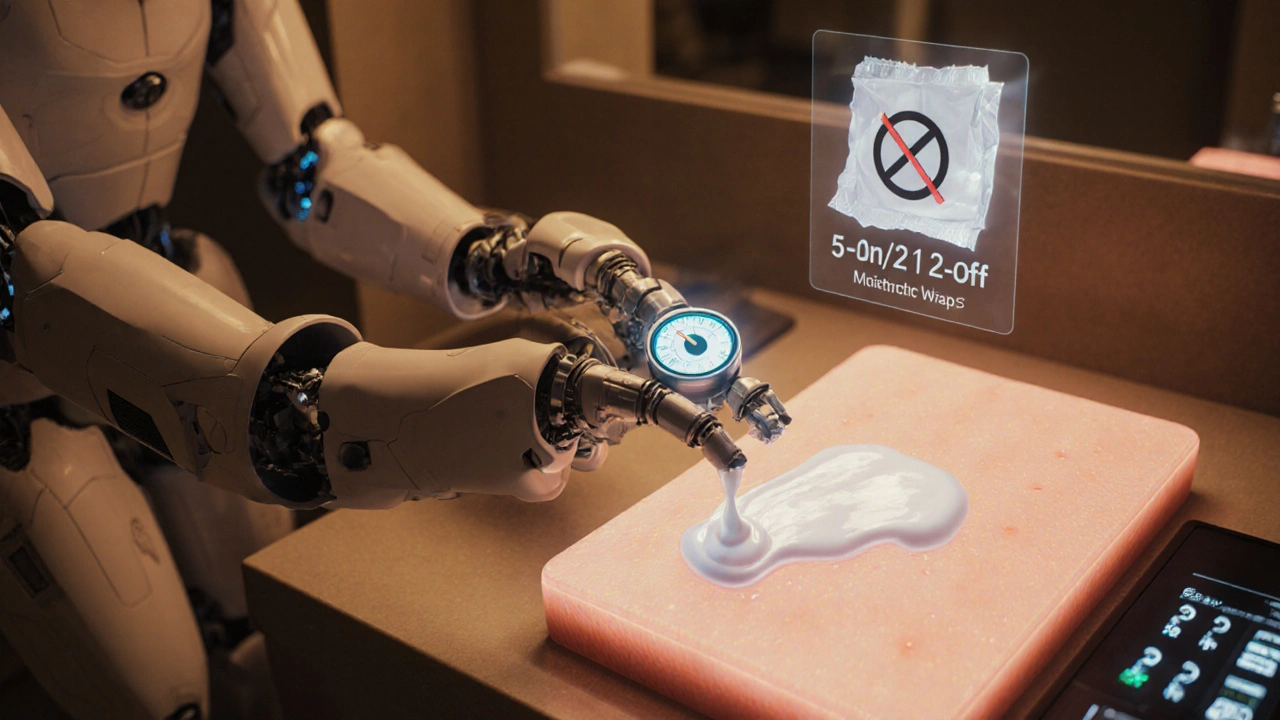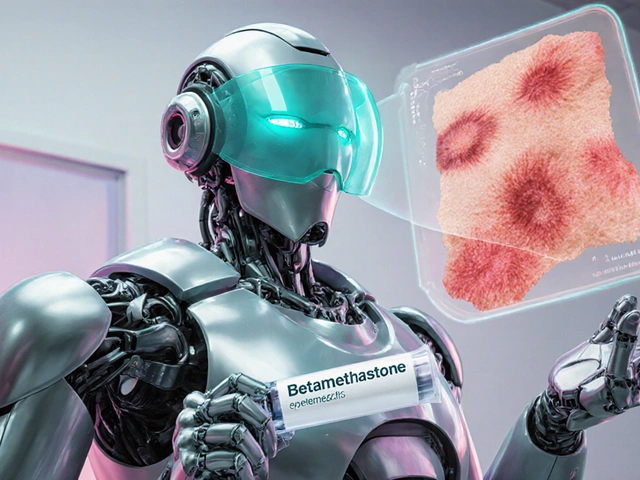Betamethasone Skin Thinning Risk Calculator
Personal Risk Assessment
Enter your treatment details to calculate your risk of skin thinning and get personalized prevention tips.
When you need a powerful anti‑inflammatory cream, Betamethasone is a go‑to high‑potency topical corticosteroid used for conditions like eczema and psoriasis. But a common side‑effect is betamethasone skin thinning, medically called skin atrophy. This guide shows how to keep your skin healthy while still getting the relief you need.
What Is Betamethasone and Why Does It Thin Skin?
Betamethasone belongs to the class of Corticosteroids. It works by dampening the immune response and reducing inflammation. The same mechanism that calms the skin also interferes with collagen synthesis and weakens the epidermal barrier, leading to thinner, more fragile skin if used improperly.
Who Is Most at Risk?
- Long‑term use (more than 2‑4 weeks) of high‑potency formulations.
- Application under occlusion (plastic wraps, thick dressings).
- Thin‑skinned areas: face, genitals, skin folds.
- Elderly patients or children, whose skin is naturally more delicate.
- Underlying conditions that already compromise the barrier, such as atopic dermatitis or psoriasis.
Preventive Strategies
Prevention is easier than fixing atrophy after it appears. Follow these practical steps:
- Pick the lowest effective potency. For many flare‑ups, a Class III steroid like triamcinolone can work; reserve betamethasone for stubborn patches.
- Limit duration. Aim for 1‑2 weeks, then reassess. If symptoms improve, taper or switch to a milder agent.
- Use intermittent dosing. Apply for 5 days, then give the skin 2 days off (pulse therapy). This reduces cumulative exposure.
- Apply the right amount. One fingertip unit (FTU) covers roughly the size of an adult’s palm (≈0.5 g). Over‑application adds unnecessary risk.
- Moisturize before and after. A thick Moisturizer or barrier‑repair cream (ceramide‑rich) restores lipids and gives the skin a protective cushion.
- Avoid occlusion unless directed. Plastic wraps trap heat and increase absorption by up to 10×, dramatically raising atrophy risk.
- Rotate with steroid‑sparing agents. Calcineurin inhibitors (pimecrolimus, tacrolimus) or vitamin D analogues (calcipotriene) control inflammation without thinning the skin.

Monitoring: Spot Early Signs of Atrophy
Regular self‑checks help catch problems early. Look for:
- Visible thinning or translucency of the skin.
- Striae (stretch marks) forming in the treated area.
- Easy bruising or visible blood vessels.
- Loss of the normal skin texture - it feels smoother, almost papery.
If you notice any of these, cut back the betamethasone immediately and discuss alternatives with a dermatologist.
If Thinning Happens: How to Recover
Stopping the high‑potency steroid is the first step. Then, adopt a skin‑repair regimen:
- Switch to a low‑potency steroid. Hydrocortisone 1% or a mild Class I/II steroid can keep inflammation in check while the skin heals.
- Introduce a topical calcineurin inhibitor. Pimecrolimus (Elidel) or tacrolimus (Protopic) are effective for eczema and do not cause atrophy.
- Use barrier‑repair moisturizers. Look for products with ceramides, hyaluronic acid, and urea - they hydrate and stimulate collagen production.
- Consider vitamin D analogues. Calcipotriene (Dovonex) helps normalize keratinocyte growth and can be combined with a mild steroid.
- Professional treatments. In severe cases, dermatologists may use laser resurfacing or soft tissue fillers to improve texture, but these are adjuncts, not first‑line solutions.

Comparison of Common Topical Steroids
| Steroid | Potency Class | Typical Indications | Risk of Atrophy |
|---|---|---|---|
| Betamethasone (dipropionate) | Class III | Psoriasis, severe eczema | High (especially with occlusion) |
| Hydrocortisone 1% | Class VII (lowest) | Mild dermatitis, diaper rash | Very low |
| Clobetasol propionate | Class I (super‑potent) | Thick plaque psoriasis | Very high - limit to < 2 weeks |
Quick Takeaways
- Start with the lowest‑potency steroid that controls your flare.
- Limit use to 1‑2 weeks; consider pulse therapy.
- Never occlude betamethasone without medical advice.
- Moisturize generously before and after each application.
- Rotate in calcineurin inhibitors or vitamin D analogues to spare the skin.
Frequently Asked Questions
Can I use betamethasone on my face?
Only under close supervision. Facial skin is thin, so a lower‑potency steroid or a short, intermittent course is safer.
How often should I moisturize when using betamethasone?
Apply a generous layer twice daily - once before the steroid and once after it has fully absorbed (about 15 minutes later). This maintains barrier function.
What are signs that I need to stop using betamethasone?
Noticeable thinning, striae, easy bruising, or a shiny, translucent appearance. Stop the medication and consult a dermatologist.
Are there any natural alternatives to prevent skin thinning?
Natural options like colloidal oatmeal baths, aloe vera gel, and evening‑primrose oil can soothe, but they don’t replace the anti‑inflammatory power of steroids. Use them as adjuncts alongside a doctor‑approved regimen.
How long does it take for skin to recover after atrophy?
Recovery varies; mild thinning may improve in 2‑3 months with proper moisturization, while deeper atrophy can take 6‑12 months or require professional treatment.


Alex Pegg
October 20, 2025 AT 20:05Betamethasone is a monster drug, and anyone who slaps it on their skin without a plan is basically courting disaster. You’d think common sense would dictate the lowest potency, but no, people love the quick fix.
Sebastian Green
November 3, 2025 AT 17:25I get where you’re coming from, the urge to get fast relief is strong, but taking a step back and moisturizing first can really cut down the risk of thinning skin.
Wesley Humble
November 17, 2025 AT 14:45The pharmacodynamics of betamethasone entail profound suppression of pro‑inflammatory cytokine cascades, a fact well‑documented in peer‑reviewed dermatological literature. Consequently, the drug exerts a catabolic effect on dermal fibroblasts, attenuating collagen synthesis and compromising extracellular matrix integrity. Empirical studies have quantified a reduction in dermal thickness by up to 30 % after two weeks of uninterrupted application on thin‑skinned sites. This phenomenon is not merely theoretical; clinical observations routinely reveal telangiectasia and striae in patients who neglect prescribed limits. It is incumbent upon prescribers to enforce a maximal duration of one to two weeks for Class III agents, unless alternative therapeutic monitoring is instituted. Moreover, the occlusive environment amplifies percutaneous absorption exponentially, an effect corroborated by in vivo flux measurements demonstrating a tenfold increase under plastic dressings. Practitioners should therefore eschew occlusion except when explicitly indicated for conditions such as ichthyosis vulgaris. From a formulation standpoint, the use of a finger‑tip unit (approximately 0.5 g) serves as a reliable metric to prevent overdose. Adjunctive barrier‑repair emollients containing ceramides or hyaluronic acid can mitigate transepidermal water loss during steroid therapy. In cases where atrophy emerges, immediate cessation of the high‑potency agent and substitution with a low‑potency corticosteroid or a calcineurin inhibitor is advisable. Topical tacrolimus, for instance, retains anti‑inflammatory efficacy while preserving dermal architecture. Vitamin D analogues such as calcipotriene complement this regimen by normalizing keratinocyte proliferation. For refractory atrophy, procedural interventions-including fractional laser resurfacing-may be considered, albeit as secondary measures. Patient education remains the cornerstone of prevention; instructing individuals to moisturize both pre‑ and post‑application fosters barrier resilience. Ultimately, the therapeutic index of betamethasone is optimized through judicious dosing, vigilant monitoring, and timely transition to steroid‑sparing agents. 😊
Vijaypal Yadav
December 1, 2025 AT 12:05While the data you cite are accurate, it’s worth noting that inter‑individual variability in enzyme expression can further modulate steroid metabolism, meaning some patients may experience atrophy even within the recommended timeframe.